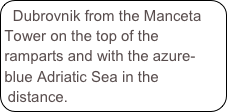The Dalmatian Coast

III: Dubrovnik
Dubrovnik is also known, justifiably, as the “Pearl of the Adriatic”. And when you visit the place you will certainly concur. The last time I was in Dubrovnik was in 1957, and I still remember staying in a small B&B on the second floor just against the ramparts with a view of the Adriatic Sea. The stalwart late-medieval stone ramparts are still there, not having changed during the intervening decades. The town did not look as if it has changed a bit, even though it had been mercilessly bombed during the Yugoslavian war.
In 1991 Croatia had declared independence from Yugoslavia after the death of Marshall Tito, and Dubrovnik, a Croatian enclave, was besieged by the Yugoslav Army. It was at the end of 1991. The Yugoslav army consisted mostly of soldiers from Serbia and Montenegro, and they were lobbing explosives from the top of the hill adjacent to the town. At that time Montenegro was part of Serbia.
At that time Dubrovnik had already been named a UNESCO World Heritage site, and the bombings created a huge international outcry against Serbia and Montenegro. The bombings were halted after a few months, and most of the damaged buildings have now been restored as closely to the original as possible. What makes Dubrovnik so memorable is that even now it is a remarkably well-preserved example of a late-medieval walled town.
To get to Dubrovnik from the north along the coast, we had to traverse a few miles of Bosnia-Hercegovina, before entering Croatia again. But customs and immigration were quite streamlined and delay was minimal.
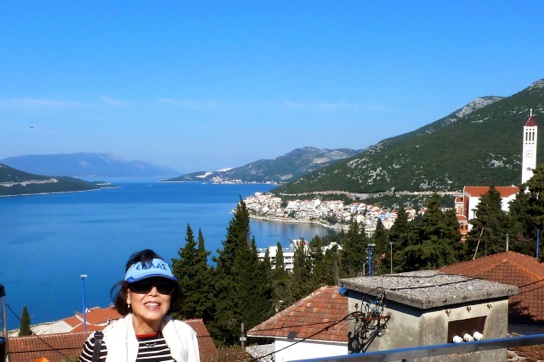
left: A gorgeous view of the Dalmatian Coast from that sliver of Bosnia, in the city of Neum
In Neum is a popular rest stop doing great business, selling a variety of stuff and alcoholic drinks at highly discounted prices. Bosnia’s official currency is the Convertible Marka (BAM) which, at the present, is around US$0.69/convertible marka. But this place also accepts euros, US dollars, or Croatian kunas.
Coming out into Croatia again, we crossed the Dr. Franjo Tuchman bridge to cross from the D8 state road into the peninsula where Dubrovnik is situated. Franjo Tuchman was the first president of Croatia, after the split from the erstwhile Yugoslavia. But he wasn’t really a friend of Dubrovnik and locals want to rename the span the Dubrovnik Bridge. Franjo Tuchman is highly regarded by many Croatians, but is also reviled by many because of his autocratic behavior, despotism, double-dealings, duplicity, and his role in the slaughter of the non-Croat population of Bosnia and Hercegovina. He was allegedly in deep collusion with Slobodan Milošević, the guy who was indicted by the International Criminal Tribunal for the former Yugoslavia.
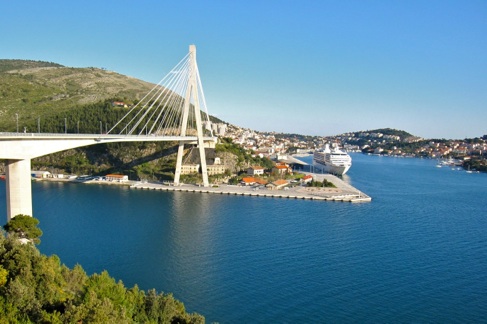
right: The Franjo Tuchman bridge with the Gruz harbor on the right. You can see a cruise ship at anchor there. The Old City of Dubrovnik is still some distance away behind the hill behind the cruise ship.
After the bridge we passed the cruise terminal in Gruz harbor. Dubrovnik is a favorite place as a port of call for cruise ships, because the city is so lovely. On the average there are 6-7 cruise ships on any day. Once there were 14 ships docking on the same day, and the city was so jammed with tourists, that a maximum number of ships which can concurrently dock has been instated. I don’t know what the number is.
The walled old town of Dubrovnik itself is not very large. There is one main street, Placa ulici, or Placa Street, but more commonly known as the Stradun, in high season or when there are lots of cruise ships in harbor thronged with tourists. Exceptionally striking is the smooth marble pavement, which makes walking easy. There is no charge to get into the city.
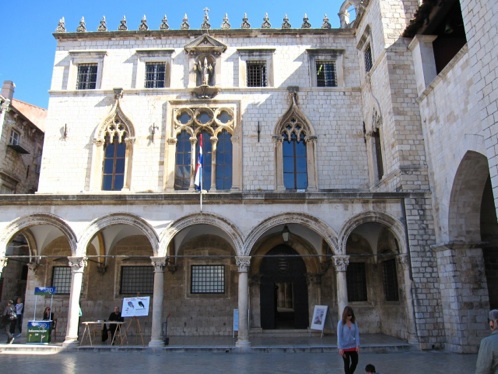
There is the town hall, now known as the Rector’s Palace, dating to the 11th century, where you can sometimes see people asking you to join to form a group, because group rates are substantially less than single entries.
left: The Rector’s Palace, at the end of the Stradun.
There is the Franciscan monastery, which was completed in the 14th century, but substantially modified later to make it largely baroque in appearance at the moment. There is the Dominican Monastery and the Cathedral, rebuilt after the 1667 earthquake. There is even a place which is reminiscent of the Spanish steps in Rome.
After you enter Pile Gate, the main entrance to the old walled town, onto the Stradun, you will find on the left the oldest pharmacy in Croatia, whatever that means. I had developed a bad cold during the travel and coughed a lot, At night I was taking dextromorphan hydrobromide, the standard cough medicine drug prescribed by doctors in the USA. But then I ran out of cough medicine and the nagging cough prevented me from getting a good night’s rest. That was bad, especially because the tour was fairly strenuous. and I needed the rest. But at this pharmacy they had a homeophatic herbal syrup based on a propiolis root extract. It was an Italian product called Propolimix, I found to my joy and surprise that this syrup was much more effective than the dextromorphan HBr I was used too; it also had fewer side-effects than the drug. Well, now I know what to take at my next cold and coughing spell.
A visit to Dubrovnik is not complete without a walk on the extensive stone ramparts. To walk around the whole perimeter is about 2 miles and it can be quite strenuous because you have to go up and down quite a number of stairs. For this you need to buy a ticket, which was 100 kuna, when we were there, which translates to around $17.60. Even at this high price, there are so many tourists in high season, that one-way traffic is instituted to make the walk more smooth. On sunny days the panoramic views are breath-taking, but the sun can be fierce and an umbrella is a useful asset. And the use of a lot of sunscreen is highly recommended. The highest point is the Minceta tower, from where you have a very nice view of the red-tiled roofs of the town, the alleyways in between, the ramparts encircling the town and the blue Adriatic Sea as background.
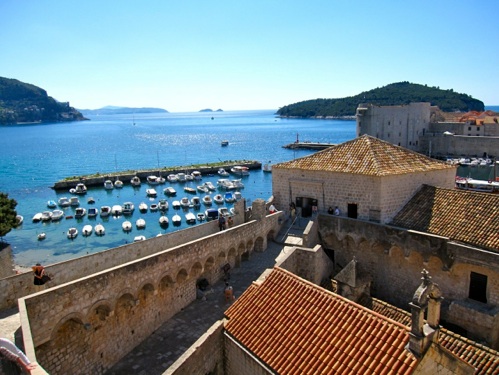
right: The harbor of the Old Town of Dubrovnik as seen from the ramparts of the town. The large island on the right in the Adriatic Sea is Locrum Island.
As befitting a world-class tourist venue, you can expect the prices the restaurants charge high. They are, but not unreasonably so. But because tourists make for very poor repeat customers (some locations have not realized the power of TripAdvisor) service is often, but not always poor. At one place the service was so slow, we just walked away in disgust.
For lunch we stopped at the Kamenice, which translates to “Oysters”, close to the harbor, very well recommended by the concierge of our hotel.
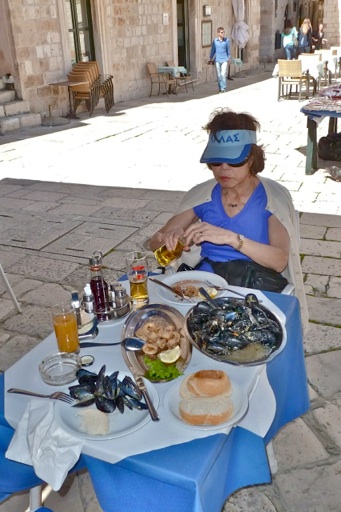
Left: A very pleasant lunch al fresco at the Kamenice Buffet. Note the huge serving of mussels.
Here the prices were surprisingly reasonable and the portions huge, especially of the very well prepared mussels, floating in a wine sauce liberally laced with garlic, enough to scare away at least ten Draculas. And the service was good and personal. The two of us could have ordered one portion and that would have been enough. They only had outdoor seating, as far as we could ascertain.
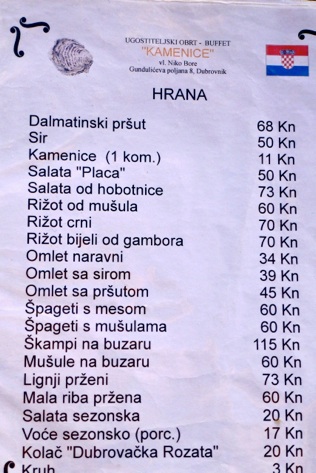
right: The menu of the Kamenice buffet. The Lignji prženi, or fried octopus, was 73 kuna; the mussels in wine sauce (Mušule na buzaru) was 60 kunas.
We also took a boat tour around Locrum Island, a large wooded island just off the city in the Adriatic Sea. There were just two passengers besides us. On the island are the remains of the Fort Royal Castle, as well as a monastery and a botanical garden. In the summer, the shores are said to be full of nude sunbathers, but we were too early and there was nobody on the rocky shores. Too bad. But some young women hospitably mooned us with their bare bottoms as we cruised past the southern walls of the city. I wish I had a camera with a better telephoto lens.
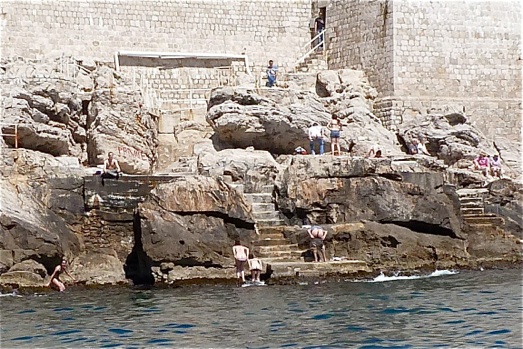
left: Several young women were mooning us with their bare bottoms, as our vessel cruised by. You should hear their hoops of joy doing this.

